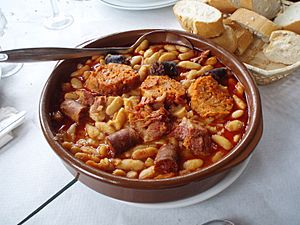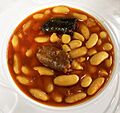Fabada asturiana facts for kids

Fabada Asturiana
|
|
| Alternative names | Fabada |
|---|---|
| Type | Stew |
| Course | Appetiser or main course |
| Place of origin | Spain |
| Region or state | Principality of Asturias |
| Serving temperature | Hot |
| Main ingredients | White beans |
| Variations | Olla podrida, cassoulet |
Fabada asturiana, often simply called fabada, is a delicious and hearty Asturian bean stew. It comes from the Principality of Asturias region in Spain. You can find it all over Spain and in Spanish restaurants around the world. You can even buy canned fabada in most supermarkets!
This warm and filling dish is usually eaten in winter. It's often the biggest meal of the day, usually for lunch. You can enjoy it as a starter or even as the main course. People often drink Asturian cider or red wine with it.
Contents
What's in Fabada?
Fabada is made with special ingredients that give it its unique flavor:
- Fabes de la Granja: These are large, white beans from Spain. They are soaked in water overnight before cooking.
- Lacón: This is a type of cured pork shoulder. Sometimes, pancetta or bacon (called tocino) is used instead.
- Morcilla: This is a Spanish blood sausage.
- Chorizo: A spicy Spanish sausage.
- Other ingredients include olive oil, sweet paprika, garlic, and salt.
A Look at Fabada's History
People in Asturias have been eating "fabes" (beans) since at least the 1500s. The type of bean used in fabada is called "de la Granja." It's known for being smooth and buttery. Farmers grow these beans on about 2,500 hectares (about 6,177 acres) of land in Asturias.
Fabada likely started as a simple dish made by everyday people. Experts think it might have been created in the 1700s, but there's no clear proof. Even though beans were a farm food, many believe fabada first became popular in cities. Old books from that time don't mention fabada, which is interesting! Some people think it might be similar to a French stew called cassoulet. This French dish could have come to Spain a long time ago through the Camino de Santiago, a famous walking route.
The first time fabada was mentioned in writing was in an Asturian newspaper in 1884. But it didn't include the recipe! Later, writers started connecting fabada to other Asturian dishes. It wasn't until the 19th and 20th centuries that fabada became widely known. Now, it's a famous dish not just in Asturias, but all over Spain.
When people from Asturias moved to other parts of the world, they brought this dish with them. That's why you can find versions of fabada in places like Tampa, Florida, in the United States.
In Colombia, there's a dish called "paisa tray" (bandeja paisa). It's a bit like fabada but uses red beans instead of white ones. It's cooked with pork leg, garlic, onion, and salt. It's often served with chorizo, pork rinds, ground meat, a fried egg, avocado, and white rice.
Similar Dishes Around the World
Fabada Asturiana is a unique dish, but some other stews from different countries are quite similar:
- The Spanish olla podrida
- The French cassoulet
- The Brazilian feijoada
Images for kids
See also
 In Spanish: Fabada para niños
In Spanish: Fabada para niños





